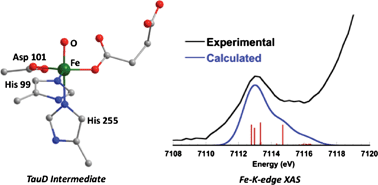In recent years, a number of high-valent iron intermediates have been identified as reactive species in iron-containing metalloproteins. Inspired by the interest in these highly reactive species, chemists have synthesized Fe(IV) and Fe(V) model complexes with terminal oxo or nitrido groups, as well as a rare example of an Fe(VI)-nitrido species. In all these cases, X-ray absorption spectroscopy has played a key role in the identification and characterization of these species, with both the energy and intensity of the pre-edge features providing spectroscopic signatures for both the oxidation state and the local site geometry. Here we build on a time-dependent DFT methodology for the prediction of Fe K- pre-edge features, previously applied to ferrous and ferric complexes, and extend it to a range of Fe(IV), Fe(V) and Fe(VI) complexes. The contributions of oxidation state, coordination environment and spin state to the spectral features are discussed. These methods are then extended to calculate the spectra of the heme active site of P450 Compound II and the non-heme active site of TauD. The potential for using these methods in a predictive manner is highlighted.

You have access to this article
 Please wait while we load your content...
Something went wrong. Try again?
Please wait while we load your content...
Something went wrong. Try again?


 Please wait while we load your content...
Please wait while we load your content...